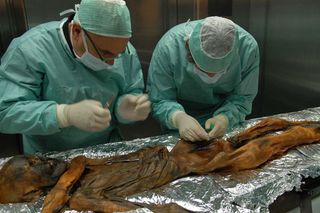Iceman Mummy May Hold Earliest Evidence of Lyme Disease

The 5,300-year-old ice mummy dubbed Ötzi, discovered in the Eastern Alps about 20 years ago, appears to have had the oldest known case of Lyme disease, new genetic analysis has revealed.
As part of work on the Iceman's genome — his complete genetic blueprint — scientists found genetic material from the bacterium responsible for the disease, which is spread by ticks and causes a rash and flulike symptoms and can lead to joint, heart and nervous system problems.
The new analysis also indicates the Iceman was lactose intolerant, predisposed to cardiovascular disease, and most likely had brown eyes and blood type O.
To sequence the Iceman's genome, researchers took a sample from his hip bone. In it, they looked for not only human DNA — the chemical code that makes up genes — but also for that of other organisms. While they found evidence of other microbes, the Lyme disease bacterium, called Borrelia burgdorferi, was the only one known to cause disease, said Albert Zink, a study researcher and head of the European Institute for Mummies and the Iceman at the European Academy of Bozen/Bolzano (EURAC) in Italy.
"Our data point to the earliest documented case of a B. burgdorferi infection in mankind. To our knowledge, no other case report about borreliosis [Lyme disease] is available for ancient or historic specimens," Zink and colleagues write in an article published on Tuesday (Feb. 28) in the journal Nature Communications.
Discovering evidence of Borrelia is an "intriguing investigative lead," said Dr. Steven Schutzer, an immunologist at the University of Medicine and Dentistry of New Jersey-New Jersey Medical School.
Schutzer is a lead investigator on a National Institutes of Health-funded project that has sequenced at least 17 strains of the modern bacterium, and has published 13 of those so far.
Sign up for the Live Science daily newsletter now
Get the world’s most fascinating discoveries delivered straight to your inbox.
The discovery of the traces of Borrelia within the sample taken from the Iceman still needs to be confirmed, he said. "Now we know what we want to look for, now that we know there is a possibility of that being here, we can do a very targeted approach that looks for Borrelia," Schutzer said.
Lyme disease is transmitted by ticks in North America and Eurasia. It was first found in the United States in Connecticut in the mid-1970s; a similar disorder had been identified in Europe earlier in the 20th century.
Schutzer said he is discussing follow-up studies with Zink.
Previous work had examined genetic material within the Iceman's mitochondria — the energy-producing centers in cells. His mitochondrial DNA,which is inherited through the maternal line, did not reveal any living relatives.
In this new project, researchers decoded the DNA found within the nuclei of the Iceman's cells, which is inherited from both parents. They found the Iceman belonged to a lineage that is now rare,but still present in some places. [Photos of Iceman Mummy]
"This means his ancestors came from Europe originally from the East and spread over most or part of Europe," Zink said. "This original population was somehow replaced by other populations, but they remained quite stable in remote areas like Sardinia and Corsica."
The analysis also indicates the Iceman was lactose intolerant. This isn't surprising, according to Zink. At the time the Iceman lived and died, people were beginning to settle down and become farmers, and the ability for adults to digest milk became an advantage.
The team also found he had a genetic predisposition for cardiovascular disease, supporting earlier scans showing the buildup of deposits within his arteries. In spite of the health problems from which the roughly 45-year-old Iceman suffered, he appears to have died a violent death. Researchers believe a flint arrowhead, shot into his left shoulder most likely killed him.
You can follow LiveScience senior writer Wynne Parry on Twitter @Wynne_Parry. Follow LiveScience for the latest in science news and discoveries on Twitter @livescience and on Facebook.
Most Popular



